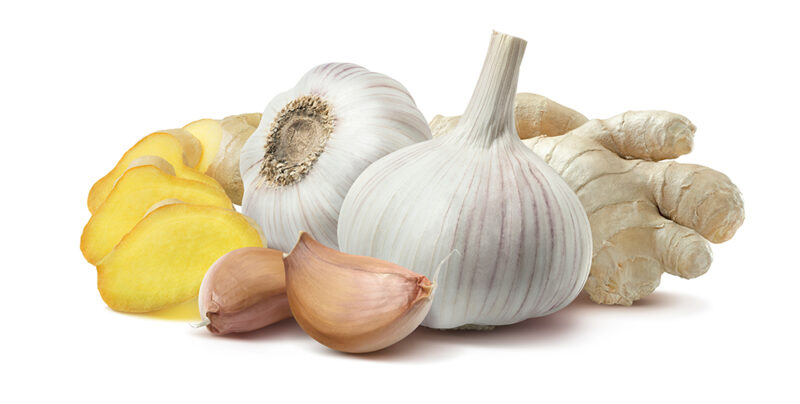
Ginger and garlic… more than just destined for your wok!
The secret to successfully treating the common cold and cough is to differentiate the type based on Traditional Chinese diagnostics (TCM) principles. Chinese medicine differentiates between three main types of colds and coughs: Wind-Cold, Wind-Heat and deficient wind- cold with many subdivisions.
We all know what a cold is and it may not necessarily be caused directly by a virus, but preceded by exposure to cold temperature, which weakens our immune system making us a welcome target for the rhinovirus to settle in and wreak havoc with our sense of well-being.
But What About Echinacea for Colds and Flu?
Nowadays people have heard of a few herbs, like echinacea, elder and even the now famous Yin Chiao formula sold by many herb companies. Most of these are for viral type “wind-heat” colds and flu.
It’s intriguing to me that even though I brought echinacea back from the brink of oblivion when I discovered it in the dregs of a jar stored in the basement of the once famous Nature’s Herb Pharmacy in San Francisco, I never found echinacea very effective for colds and flu. This was corroborated by a human study conducted by the esteemed Bastyr Naturopathic university. [1]
What echinacea is effective for is bacterial infections including Staph and Strep. I’ve successfully used echinacea for thousands of people who were often not responsive to pharmaceutical antibiotics and many with intractable infections. While echinacea was the most widely used and effective herb for infections before 1930, soon antibiotics were developed and people ignorant of the any possible adverse consequences would run to the doctor’s office to ask for the new antibiotic drugs. It was then that echinacea was nearly forgotten.
Madaus, a pharmaceutical company based in Germany, who manufactured herbal products, grew echinacea from seeds they acquired in North America. They then engaged two highly respected researchers to investigate the plant and they concluded it was good for the immune system (which nowadays, could mean many things). Madaus then promoted echinacea as the best remedy for the common cold.
I’m here to say after 40 years of clinical practice echinacea is not the best herb for the common cold. It’s good for bacterial (non-Wind) type infections. Don’t get me wrong, I think Madaus is one of the great herbal product manufacturers worldwide, but deliberate or not, I think they made a big mistake in their marketing of echinacea and since then every company and herbalist who doesn’t know better still circulates the myth of “echinacea for colds.” Depending on the cold you have, there may be better herbal options, including two that are probably already in your pantry or refrigerator.
Garlic and Ginger for Colds and Coughs
Back to TCM diagnosis: What is “cold” and what is “external Wind?” External Wind is a term the Chinese use to describe a condition affecting the respiratory system with sudden onset, like a cold or flu or allergies, or spreads on the skin, like skin rashes, similar to a histamine reaction. (This is distinguished from “Internal Wind” which is characterized by symptoms of tremors, dizziness, strokes and describes diseases like Parkinson’s or epilepsy.)
What are the TCM symptoms of the “External Wind-Cold”? Obviously the first symptom is feeling of ‘cold’, with occasional chills which may or may not be accompanied by a low grade fever. The ‘cold’ part of the diagnosis naturally calls for the use of a warm-natured remedy, usually herbs.
While professional Chinese doctors may prescribe more complex remedies for Wind-Cold colds, common folk healers use a remedy of scallion stalks. Scallions belong to the Allium family to which garlic also belongs. In the West, garlic is the common wonder-herb commonly used by Italians and Greeks as a virtual heal all from the common cold to promoting hair growth and impotency. It’s perhaps the strongest of all Alliums and the one I recommend both for high efficacy and convenience. It’s also used in China and India, but perhaps less so because for professional herbalists perhaps because it is too plebian or smelly (it is sometimes called the stinking lily). This is not an obstacle to Italians, Greeks and Arabs and to many Western herbalists throughout South and North America and Europe.
To make perhaps the best powerhouse combo for beating External Wind Cold type colds I would pair garlic with a second herb which is no less famous: fresh ginger. Ginger is widely used by Chinese herbalists, and throughout the world. It is used either fresh or dried, with the dried having more concentrated gingerol making it hotter and ideal for internal cold (digestive issues).
I don’t have a precise recipe and generally don’t believe in them when it comes to folk remedies. I would use four of five garlic cloves or as many or few as tolerated for a single serving. Peel and chop.
Fresh ginger is available in most markets. Simply cut 4 or 5 slices for use.
Put both chopped garlic and ginger in 1 ½ cups of boiling water, cover and remove from the flame to cool.
Sip this through the day or take at least 3 cups daily. If it is truly an External Wind-Cold, you should feel immediately better, with symptoms of chills, drippy nose, and cough disappearing.
Finally, garlic and ginger complement each other in this formula, either could be used as a single but using both are better, covering a wider territory so to speak but and I’m sure most of you have both. Another way to take, and perhaps enjoy garlic, is after chopping the cloves lightly sauté them, only slightly browning in olive oil, and mix with food or eat directly. I’ve found lightly sauteed garlic in olive oil to be much more pleasant to take and perhaps more effective.
[1] https://bastyr.edu/research/studies/echinacea-purpurea-prevention-upper-respiratory-tract-infections-children
